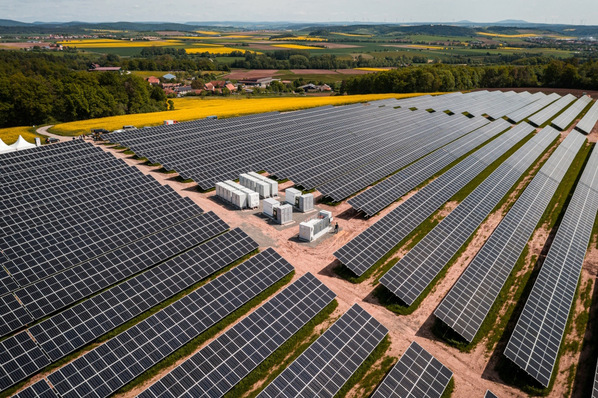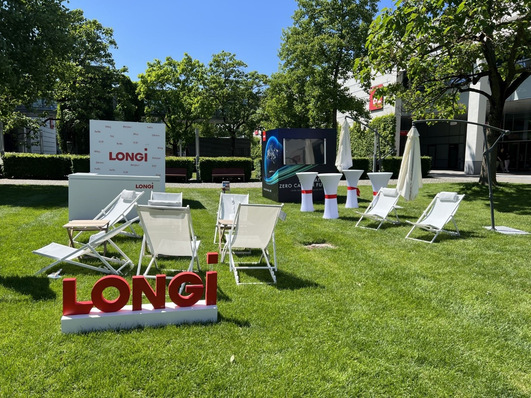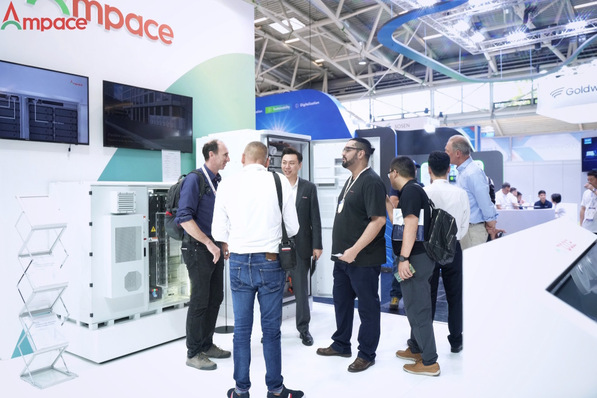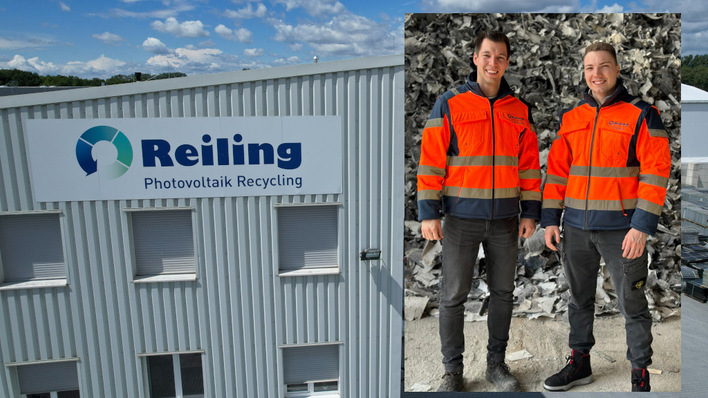Tom Zhao is your typical Chinese man: short and slim, with sparkling eyes which he occasionally hides behind a pair of dark sun glasses. Then he looks more like a seedy character from Hong Kong’s underbelly than a solar expert. It is easy to underestimate him. But he is a globally active manager with great organisational skills – and what is more: He is absolutely committed. Get him started on photovoltaics and he immediately takes off his sun glasses. And then you can see the light in his eyes.
Zhao is head of the solar segment at the Chinese technology corporation BYD (Build Your Dreams). He joined the company that operates a number of factories in China in 2008. Prior to that, he worked for Motorola for 17 years. It was Zhao who established the solar segment at BYD. He made the connection between Apple and the Chinese component supplier. This should not be undervalued: Next to Tesla, BYD is the only global corporation that develops, manufactures and sells everything from PV to storage to EVs.
Nothing compares to BYD
Neither the automotive giant Germany nor countries like Korea or Japan have anything that compares to BYD. LG or Samsung manufacture solar panels and lithium storage units, but no cars. In contrast to Tesla, BYD builds much more storage: from the new B-Box to large container units of several megawatt hours. “Our solar panel factories currently have a capacity of about 1.5 gigawatts,” Tom Zhao says. “They operate flat out. And the battery plants are also running full tilt.”
While the European energy storage sector is still mulling over the issue of manufacturing battery cells locally, BYD has already churned out four lithium-cell factories with a combined capacity of .6 gigawatt hours. 90 percent of this go straight to the automotive industry. “Stationary storage is currently ten percent of our sales,” Zhao confirms.

New solar panel factory in Brazil
In contrast to other panel manufacturers from China, BYD has no qualms with building their factories outside of Asia: Recently, a state-of-the-art panel factory started production in Brazil. They focus on durable glass-glass panels that BYD had presented two years ago at the Intersolar in Munich. One megawatt of these have already been fitted in an installation in Germany that is operational since September 2015. “Worldwide we installed about 100 megawatts in 2016,” Tom Zhao confirms. “The opportunities for growth are massive.”
This double-glass panel was developed as a project-specific panel. It has three connection sockets to help with the installation and has no issues with PID.
Pioneers in lithium energy storage
BYD was founded in 1995 and their headquarters are in Shenzhen. This mega city was once the first Special Economic Zone established by Deng Xiaoping following the death of Mao Zedong. Today, this rapidly growing city pushes up to the hills of Kowloon which mark the border between Hong Kong and the Chinese mainland.
BYD was one of the pioneers of rechargeable batteries for mobile phones, smart phones and other applications. Globally, they are one of the major suppliers in this segment. A number of years ago, their engineers began applying this expertise to two of the key future areas of business: They started developing EVs and BYD was one of the first manufacturers to get involved in stationary storage. The corporation now has over 50 branch offices around the world.

The first electric vehicle as early as 2009
Their first vehicle in 2009 was a hybrid: the F3DM. This car was exclusively sold to as a fleet vehicle to state-run companies, taxi firms, the police, the postal service and the government. Now their product range is very broad, with a focus on fully electric cars.
They are available all over the world, even in Iran. As of late, they are also being imported into Europe (via Rotterdam). Chiefly among them is the e6, a fully equipped and fully electric four-door saloon, which will at first be used in taxi fleets. Because of its 80-kilowatt hour battery, this cross over vehicle has a range of 400 kilometres. At a price of 50,000 euros (excluding VAT), this EV has a system price of about 600 euros per kilowatt hour of storage capacity. Thus the investment cost is 12,500 net euros per 100 kilometres of electric ranger.
Another favourable everyday aspect is also the rapid-charging capability of the batteries: Using the nearly ubiquitous public type-2 AC charge points, the e6 can be charged with up to 40 kilowatts. That way, even charging it for half an hour will give another 100 kilometres of range. To fully charge the battery takes two hours. The service life of the battery is quoted as being 1.4 million kilometres. This is based on the 4,000 charging cycles and a residual capacity of 75 percent that are covered by BYD’s warranty. The warranty for the vehicle itself is two years or 150,000 kilometres.
Currently 16 models
The e6 has six airbags as standard, including two side airbags. ESP and a braking assistant are also included ex factory. Top speed is 140 kilometres per hour, which the motor achieves due to its 332 foot-pounds of torque and a maximum output of 90 kilowatts. The boot has a volume of 450 litres. In contrast to most other EVs, the e6 can also provide power to other vehicles (vehicle to vehicle) and can be used as a mobile power source (vehicle to load). BYD has a total of 16 different models of car – from a compact car to an SUV, all of them fully electric.
Further, an e-bus was developed which has been available as an articulated bus since 2014 and a double-decker since 2016. At the time the BYD C9 was the only fully electric coach in the world. In addition to the personal vehicles, BYD came out with a number of electric lorries, terminal tractors and with the T9 the world’s first fully electric three-axle semi-trailer tractor. Unfortunately, this is so for only available in Asia and the US. And then there are also fork-lifts and low-platform lorries.
Globally, China is the leading market for electric mobility – and BYD are its biggest player. According to a current study by Bloomberg New Energy Finance, BYD even sells more EVs than Tesla. In 2016, they shipped about 102,500 vehicles, mostly in China. Tesla on the other hand only sold 75,000 cars. However, because their cars are more expensive, Tesla had a greater turnover. Bloomberg estimated Tesla’s 2016 turnover to be 6.35 billion US dollars, against BYD’s 3.88 billion US dollars.
Looking to the mass market
The Chinese are clearly looking to the global mass market. Their potential for growth is much better than that of Tesla, as the Americans are far from making the jump into mass production – neither in cars nor in stationary storage. In terms of technology, the Chinese are also playing in the top league: The three top selling EVs of last year were the Tesla Model S, the Nissan Leaf and BYD’s Tang. Looking at the top ten, Tesla has a second entry (the Model X), but BYD has a total of three.
About 700,000 EVs were sold globally in 2016, more or less half of these in China. This means that the market there has doubled within a single year. This year (2017) this growth might even increase even stronger, as the first quarters were very promising. Compared to the overall volume of car sales (88 million in 2016) this might still seem insignificant. But that is exactly how it was for photovoltaics in the beginning.
The EV market in the US grows by one third every year. In Norway, every third newly registered car is an EV. For 2017, the experts from Bloomberg New Energy Finance predict that this market will grow by 55 percent globally.
Large-scale energy storage systems in containers
When it comes to stationary storage, BYD are clearly focussing on industrial applications, such as balancing power grids. In the UK, they are operating a 60-megawatt hour project. The battery system is used to control the frequency of the grid. In doing so, it goes through five to six charging cycles in a day. “At the end of the first year of operation we had gained extensive experience with this technology,” Tom Zhao remarks. “Now we would like to pave the way for other such projects. After all, this is a very very fast-growing market.”
At the Intersolar 2017, BYD presented the new B-Box HV (high voltage) which by now can be ordered from all major wholesalers in Europe. The first consignment of 1,000 storage units is supposed to reach Rotterdam by this autumn.
While BYD can rely on a vibrant domestic market when it comes to solar panels, large-scale storage and EVs, they still depend heavily on exports for smaller storage units: This is a key difference to Tesla, the top dog in the US: “In China there are still very few decentralised systems for electricity storage,” Tom Zhao confirms. “This segment continues to develop very slowly, for instance along the east coast of China. So far, we do not have an internal market for domestic storage units here.” (HS)
Read more about energy storage
Stay informed, get our free newsletter twice a week. Register here.
More useful information:
http://www.pveurope.eu/News/Energy-Storage/Flexible-with-modular-expandable-energy-storage-systems
https://www.pveurope.eu/e-mobility/chinese-electric-car-now-available-europe







